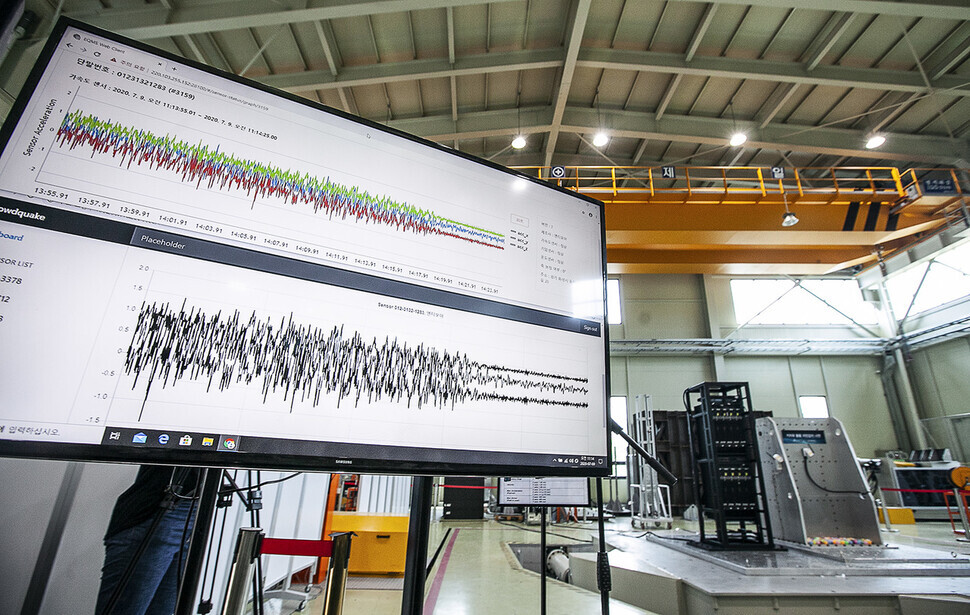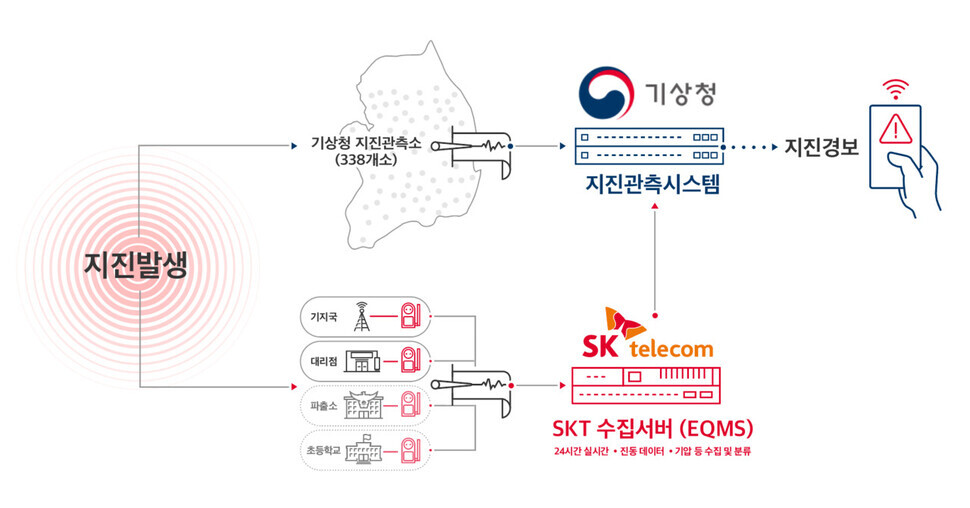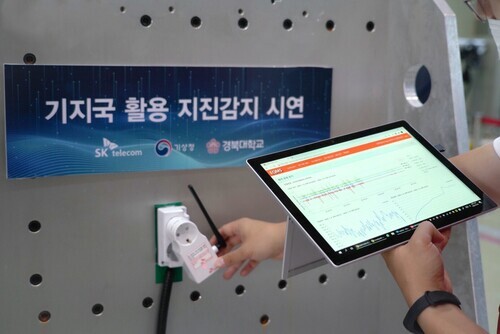hankyoreh
Links to other country sites 다른 나라 사이트 링크
S. Korean researchers develop portable earthquake measuring device

At 11 am on July 9, an artificial earthquake test was conducted at SGS Korea’s earthquake-resistant experimental center at Dongtan, in Hwasong, Gyeonggi Province, a site that contains the world’s largest seismic testing equipment. The magnitude 6 artificial tremor produced in the experiment recreated the terror of an earthquake, savagely rattling the computer gear and test equipment fastened to an earthquake-resistant experimental platform with a roar.
An IoT vibration sensor the size of a human hand was plugged into a 220 volt power outlet on the experimental platform. After a few seconds of rattling, the sensor drew a graph of the earthquake waves on a monitor. This small detector is designed to collect 100 iterations of vibration data each second, making it capable of distinguishing earthquakes from routine vibrations.
SK Telecom (SKT) announced on July 9 that it will set up a network of small portable earthquake sensors to monitor seismic activity on the Korean Peninsula in partnership with the Korea Meteorological Administration (KMA) and Kyungpook National University. SKT also carried out a demonstration of earthquake data detection and transmission.
SKT said it will install the portable vibration sensors — which the company designed itself — at 3,000 base stations and retail outlets around the country. By the end of the year, it plans to expand distribution to 8,000 other sites, including police boxes and elementary schools throughout Korea.

The KMA currently issues earthquake warnings based on measurements it makes at 338 monitoring stations around Korea. When an earthquake of magnitude 6 or above occurs, alerts are sent out to all active smartphones in the country (equipped with 4G technology or better), but the earthquake that hit Gyeongju in 2016 had a magnitude of 5.8.
Earthquake warnings are released upon the detection of the P-waves released at the beginning of an earthquake so as to limit the damage caused by the slower, but more powerful, S-waves. Since the two waves are separated by a gap of between 7 and 25 seconds, the KMA’s goal is to accelerate its reaction time so that citizens can be alerted before the S-waves arrive.
It used to take 50 seconds after an earthquake struck to send out the warning, but that was shortened to 19 seconds in the 2017 Pohang earthquake. The seismic monitoring stations around the country are separated by about 18km. Acquiring data from the denser network of earthquake sensors that SKT plans to install will make it possible to collect and disseminate more accurate seismic information for each region, the KMA said.

“If a 5.0 magnitude earthquake strikes Pohang, differences in the speed and intensity of the seismic waves call for disparate responses from people in Daegu, which is 50km away, and people in Daejeon, which is 150km away. That requires more density and precision in seismic monitoring,” explained Kwon Yeong-woo, a professor at Kyungpook National University and director of the Hyper-Connected Convergence Institute, on July 9. Kwon presented examples of how similar small seismic sensors were being used in Taiwan and California.
While a system of earthquake monitoring using vibration sensors is affordable and convenient, it cannot guarantee accuracy and reliability. As such, it can only supplement, rather than replace, the current system of seismic monitoring stations. The problem is that the detection environment varies with each building and installation site. “We created guidelines so that users will install the sensors on concrete load-bearing walls on the first floor of their building,” said Kwon.
“Because the sensors’ measurements aren’t as precise as our monitoring stations, they probably won’t be able to speed up our alerts for now. But they’ll be very useful in terms of the extensive data they provide,” said Lee Deok-gi, the KMA’s head of seismic and volcanological research.
By Koo Bon-kwon, senior staff writer
Please direct comments or questions to [english@hani.co.kr]

Editorial・opinion
![[Column] Park Geun-hye déjà vu in Yoon Suk-yeol [Column] Park Geun-hye déjà vu in Yoon Suk-yeol](https://flexible.img.hani.co.kr/flexible/normal/500/300/imgdb/original/2024/0424/651713945113788.jpg) [Column] Park Geun-hye déjà vu in Yoon Suk-yeol
[Column] Park Geun-hye déjà vu in Yoon Suk-yeol![[Editorial] New weight of N. Korea’s nuclear threats makes dialogue all the more urgent [Editorial] New weight of N. Korea’s nuclear threats makes dialogue all the more urgent](https://flexible.img.hani.co.kr/flexible/normal/500/300/imgdb/original/2024/0424/7317139454662664.jpg) [Editorial] New weight of N. Korea’s nuclear threats makes dialogue all the more urgent
[Editorial] New weight of N. Korea’s nuclear threats makes dialogue all the more urgent- [Guest essay] The real reason Korea’s new right wants to dub Rhee a founding father
- [Column] ‘Choson’: Is it time we start referring to N. Korea in its own terms?
- [Editorial] Japan’s rewriting of history with Korea has gone too far
- [Column] The president’s questionable capacity for dialogue
- [Column] Are chaebol firms just pizza pies for families to divvy up as they please?
- [Column] Has Korea, too, crossed the Rubicon on China?
- [Correspondent’s column] In Japan’s alliance with US, echoes of its past alliances with UK
- [Editorial] Does Yoon think the Korean public is wrong?
Most viewed articles
- 1‘We must say no’: Seoul defense chief on Korean, USFK involvement in hypothetical Taiwan crisis
- 2N. Korean delegation’s trip to Iran shows how Pyongyang is leveraging ties with Moscow
- 3Amnesty notes ‘erosion’ of freedom of expression in Korea in annual human rights report
- 4[Column] Park Geun-hye déjà vu in Yoon Suk-yeol
- 5‘Weddingflation’ breaks the bank for Korean couples-to-be
- 6[Reportage] On US campuses, student risk arrest as they call for divestment from Israel
- 7[Guest essay] The real reason Korea’s new right wants to dub Rhee a founding father
- 8[Editorial] New weight of N. Korea’s nuclear threats makes dialogue all the more urgent
- 9Will NewJeans end up collateral damage in internal feud at K-pop juggernaut Hybe?
- 10Why Korea shouldn’t welcome Japan’s newly beefed up defense cooperation with US